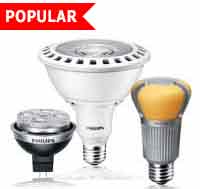Shedding light on how to choose the best bulb
About five years ago, various provinces began working toward eliminating old-fashioned incandescent light bulbs from our lives. The idea is that since such a small part of electricity used by incandescent bulbs actually gets turned into light, these bulbs must be wasteful.
The true situation is more complicated and I believe incandescent bulbs are not the bad things they're made out to be. But whether you agree with me or not, we all face the need to buy different sorts of light bulbs in the future and choosing wisely isn't as easy as it looks.One of the brightest lights on the new bulb horizon is offered by LED technology. This acronym stands for Light Emitting Diode and it's much better than the transitional technology of compact fluorescent bulbs. LEDs offer the potential for much greater lifespan and lower energy consumption than anything else. That said, I use the word "potential" for a reason.
The high price of LED bulbs has attracted hucksters to the market. Sooner or later, you'll be standing in a hardware store aisle, looking at two 100-watt LED light bulbs. One bulb costs $45, the other one $8. Which is the more economical choice?
Tom Herstad knows more about the flood of bad, expensive LED lights than most people because he's trying to counter this deceptive trend. It's not easy. He makes it his business to bring high-quality LEDs to market through his company, Regal Lighting Designs (regalleds.com; 888-900-0702) and he offers several things to look for as you assess LED bulbs.
The main issue is something called thermal management. Even though LEDs do use less energy than incandescent bulbs, they still need to get rid of waste heat - more waste heat than you might think, in fact. Greater surface area on cooling fins (thin, fin-like protrusions that increase surface area to boost the rate of heat loss) is better than less and that's something you can compare by eye in stores. In tests I conducted in my shop, full-sized LEDs made to thread into conventional sockets had fins that become too hot to touch after 15 minutes of use. Fins are definitely an important issue. "Cheap LEDs have no heat-management features," says Herstad, "and that's one reason they fail more quickly than they should."
Another thing to watch for is price. Bargain-basement $8 LEDs deliver less value than $45 equivalents because they burn out proportionally faster while delivering less light. Herstad says that of all the offshore LED manufacturing countries, Taiwan currently shows the highest commitment to quality along with reasonable price levels. Country of origin is another thing you can look for as you shop.
Today's best LEDs offer warm tones of light equal to incandescents. Look for lights rated to deliver light in the 2700 kelvin (K) range of colour temperature. Many people find colour temperatures higher than this to be too white and clinical looking.
There's a growing citizens' movement to halt the various bans on incandescent bulbs in Canada, mostly based on the high cost of alternatives. Whether or not these bans are actually repealed, it still makes sense to know how to choose and where to use today's best lighting technology, even if inventor Thomas Edison's famous light bulb is not the big bad threat it's made out to be.
Source: Ottawa Citizen


















Comments